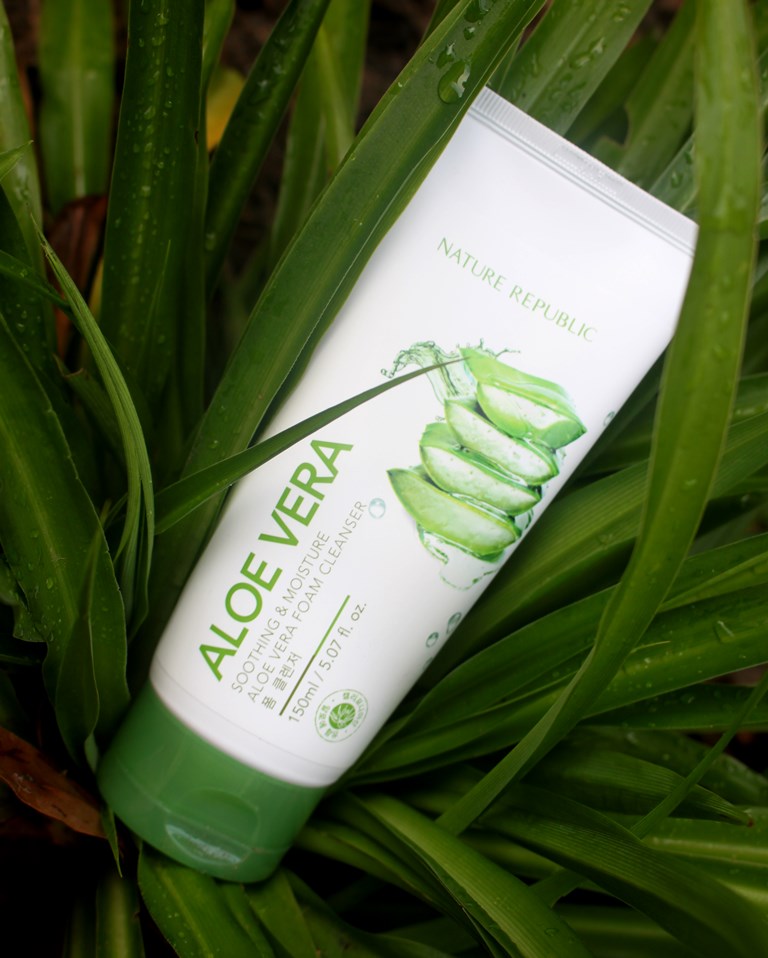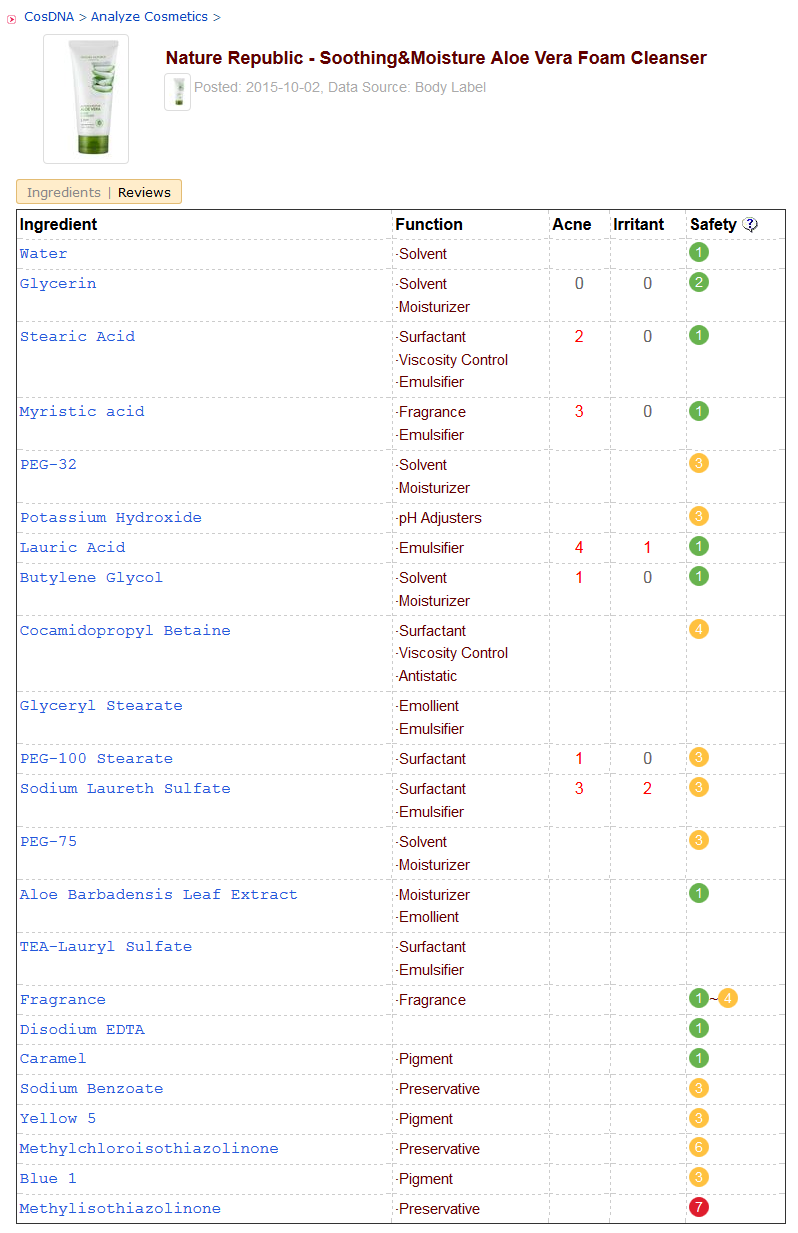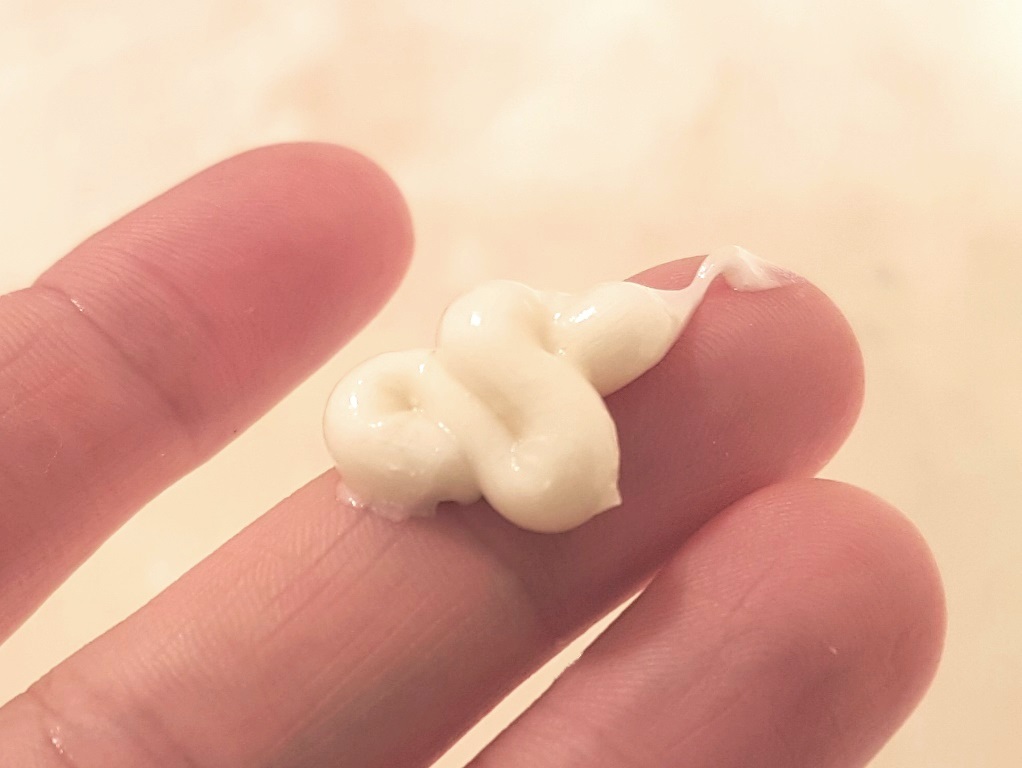
Nature Republic Aloe Vera Foam Cleanser
the claim
Nature Republic Aloe Vera Foam Cleanser removes impurities from your skin with its creamy foam, which contains aloe vera extract.

the science
As with many skincare products, Glycerin’s humectant properties see it listed second in this formulation following water. It moisturises the skin by drawing water from the air into the skin’s surface, simultaneously creating a protective layer to prevent moisture loss. Aloe Vera Leaf Extract can soothe skin and serves as an anti-inflammatory as well as acting as a moisturiser. Full of antibacterial and anti-inflammatory capabilities, Lauric acid is derived from coconut and used for its skin repairing, anti-acne and cleansing properties.
Myristic Acid, Stearic Acid, Cocamidopropyl Betaine and Sodium Laureth Sulfate (SLS) are surfactants. Oils have a higher surface tension than water. Surfactants lower oil’s surface tension so water can combine with the oil molecules and wash impurities away. However, SLS is one of the most sensitizing cleansing agents used in skincare products.
Then there’s the preservatives to prolong the product shelf life. Methylisothiazolinone and Methylchloroisothiazolinone, are capable of preventing a wide variety of bacteria and fungi from growing. They are potential allergens which are only approved for use in rinse-off formulas and at low concentrations. Their appearance at the end of the ingredient list suggests this is the case.
the ingredients
Water, Glycerin, Stearic Acid, Myristic Acid, Peg-32, Potassium Hydroxide, Lauric Acid, Butylene Glycol, Cocamidopropyl Betaine, Glyceryl Stearate, Peg-100 Stearate, Sodium Laureth Sulfate, Peg-75, Aloe Barbadensis Leaf Extract, Tea-Lauryl Sulfate, Fragrance (Parfum), Disodium EDTA, Caramel, Sodium Benzoate, Yellow 5 (cl 19140), Methylchloroisothiazolinone, Blue 1 (CL 42090), Methylisothiazolinone
the packaging
The Nature Republic Aloe Vera Foam Cleanser comes in a 150g plastic squeeze tube.
the analysis
As expected following from the science discussion, both the CosDNA and the EWG Reports give the foam cleanser a moderate hazard rating. This is primarily due to the choice of preservative and addition of fragrance.

the application
Squeeze cleanser onto hand, add water and work into a rich lather. Gently massage on face and rinse thoroughly with warm water.

the scent
The Nature Republic Aloe Vera Foam Cleanser has a sweet fragrance which reminds me of watermelon.
the cost
The 150g tube of Nature Republic Aloe Vera Foam Cleanser sells for approximately AUD$12.00.
the availability
The Nature Republic brand is readily available online and from skincare boutiques such as Style Korean, Yes Style and iHerb.
the expiry
The product has at least a two year shelf life since expiry is dated this period into the future. I cannot see any use requirements following opening, so would suggest discarding after 12 months.
the performance
 I bought this product on a whim based on a few reviews online and the reputation of the Nature Republic highly popular soothing gel. Clearly, Nature Republic stresses the importance of Aloe Vera in both products, evident in the name and image used each time. However, unlike their soothing gel, aloe vera is not found at the same impressive 92% concentration in this formulation. Rather, it is in position 14 of 22 ingredients listed in order of concentration, just before perfume. This implies a far less significant amount. Then again, this product’s primary purpose is not to moisturise or soothe but to cleanse.
I bought this product on a whim based on a few reviews online and the reputation of the Nature Republic highly popular soothing gel. Clearly, Nature Republic stresses the importance of Aloe Vera in both products, evident in the name and image used each time. However, unlike their soothing gel, aloe vera is not found at the same impressive 92% concentration in this formulation. Rather, it is in position 14 of 22 ingredients listed in order of concentration, just before perfume. This implies a far less significant amount. Then again, this product’s primary purpose is not to moisturise or soothe but to cleanse.
The cleanser has a nice consistency and is easy to dispense and apply. The fragrance is something like bubblegum or watermelon, either way, I don’t particularly like it. It’s not offensive but just unnecessary and I could see this being irritating to those with sensitivities.
It applies well, lathers nicely and rinses off easily leaving skin feeling clean. The product does leave my skin feeling a little tight once it’s fully dry. A pH of around 9.0 would support this observation.

I was disappointed to see some controversial ingredients in this formulation, none more so than Sodium lauryl sulfate (SLS). SLS is considered a standard comparison substance for measuring the skin sensitization of other ingredients. In scientific studies, when the researchers want to establish whether or not an ingredient is problematic for skin, they compare its effect to that of SLS. Skincare companies that pride themselves on using a high percentage of safe ingredients will often boast their products are free of SLS.
The preservatives in this formulation are also not desirable, being potential allergens. Historically, Methylisothiazolinone (MI) and Methylchloroisothiazolinone (MCI), are used in various rinse-off and leave-on formulations. More recently, due to concerns being raised about potentially increasing rates of skin sensitivity to MI, some cosmetic and personal care product manufacturers have begun removing it from leave-on products such as lotions and wipes altogether. This can only be considered a recognition of doubt that these preservatives are in fact completely safe.
This is a step in the right direction. However, where this ingredient remains, I interpret this simply as cosmetic companies putting in something less than safe to keep their product fresh longer, claiming there is not enough in it to hurt you. Alternatively in this case (being a rinse off product), it’s supposedly not on our skin long enough to cause any damage. If it’s toxic at any concentration under any conditions, then it doesn’t belong in or on our bodies!
the conclusion
I love Korean skincare, particularly its focus on natural and gentle ingredients. Nature Republic has disappointingly used several not-so-gentle and not-so-natural components to make this product do the things it claims. As well as the chemicals mentioned, there are also artificial colours and fragrance added to this formulation. This product contains so many controversial and potentially dangerous ingredients that it fails to retain any credibility in my eyes. I know it’s a favourite of many, but I personally don’t like this cleansing foam for so many reasons.
the summary
| Pros | Cons |
| Well priced | Only available online in Australia |
| Generates a satisfying foam | Potentially dangerous, (at least sensitizing) ingredients |
| Cleans relatively well | Drying, alkaline pH of 9.0 |
| Added fragrance | |
| Added colours | |
the references
Nature Republic website
Methylisothiazolinone (MIT) Truth In Aging
Is Glycerin Good or Bad for Your Skin? Truth In Aging
Potassium Hydroxide Paula’s Choice Skincare Dictionary
Lauric Acid Naturally Thinking
Why is cocamidopropyl betaine in skin cleansers? Sarah Siddons
Sodium Lauryl Sulfate Paula’s Choice Skincare Dictionary
Methylchloroisothiazolinone and Methylisothiazolinone Cosmetics Info
the disclaimer
Please read in context with my disclaimer.


4 Comments
Linneth Gamilla
Is it safe for pregnancy?
denise
Hi Linneth and thank you for your inquiry. As I am a skin enthusiast and not a chemist or dermatologist, I don’t wish to advise you on this. Best you contact Nature Republic directly or take the ingredient list to your obstetrician for a professional medical assessment.
Rebilyn
Is it ok to used this aloe vera facial wash together with St. Ives facial scrub?
denise
The Nature Republic is a straight out cleanser, whereas I consider the St Ives scrub to be an exfoliator (even though the brand calls it a cleanser). I wouldn’t use the scrub as my every day cleanser, rather limit it to 2-3 times a week (as I would any exfoliating product). Since the St Ives cleans as well as resurfaces, I don’t see the need to use both in the same routine, it may result in stripping your moisture barrier. Hope that helps.